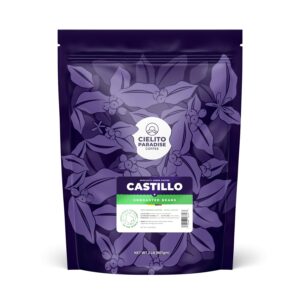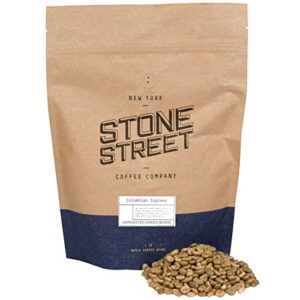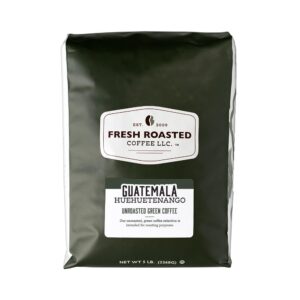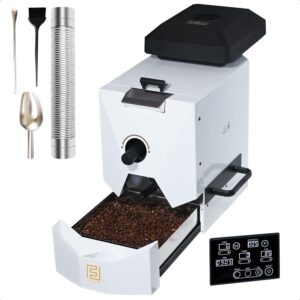Green coffee beans are the foundation of exceptional coffee. For home roasters and small-scale coffee businesses, sourcing high-quality green beans is significant in achieving outstanding flavor profiles and consistent results.
This complete guide explores the key factors in selecting and purchasing green coffee beans, drawing insights from industry experts, academic research, and community experiences.
Understanding Green Coffee Bean Quality
The quality of green coffee beans is influenced by various factors, including origin, altitude, processing method, and physical characteristics. High-quality beans typically come from specific farms or cooperatives as opposed to vague regional designations.
These beans are often grown at higher altitudes, which contribute to more complex acidity and sweetness in the final cup.
Processing methods play a significant role in flavor development. Natural (dry) processing tends to produce heavy-bodied, fruity, and sweet flavors, while washed (wet) processing emphasizes clarity and brightness, commonly found in Central American coffees.
Understanding these processing methods helps in selecting beans that align with desired flavor profiles.
Physical quality is another crucial aspect. High-quality green coffee beans should be uniform in size, color, and shape.
This consistency confirms even roasting and flavor development.
Beans with visible defects, such as wormholes or discoloration, should be avoided as they show poor sorting and can negatively impact the final product.
Ethical Sourcing and Sustainability
Ethical sourcing has become increasingly important in the coffee industry. Many consumers and roasters prioritize beans that are sourced through fair trade practices or direct trade relationships.
These approaches confirm that farmers receive fair compensation for their crops and often lead to higher quality beans because of improved farming practices.
Certifications such as Fair Trade, Rainforest Alliance, or organic can provide assurance of ethical and sustainable practices. However, some small-scale roasters prefer to establish direct relationships with farmers or cooperatives, which can lead to unique, high-quality batches and a deeper understanding of the coffee’s origin.
Where to Buy Green Coffee Beans
There are several options for purchasing green coffee beans, each with its own advantages:
Online Retailers
Platforms like Sweet Maria’s, Coffee Bean Corral, and Genuine Origin offer diverse selections of specialty-grade Arabica beans. These retailers cater to both home roasters and small businesses, providing detailed information about each coffee’s origin, processing method, and flavor profile.
Many offer sampler packs, allowing buyers to test small quantities before committing to larger purchases.
Importers
For larger orders, companies like Sucafina and Condesa specialize in handling logistics and providing comprehensive information about producers and roast profiles. These importers are ideal for businesses requiring bulk purchases and consistent supply.
Direct Trade
Establishing direct relationships with farmers or cooperatives can yield unique, high-quality batches. This approach enhances traceability and often results in more sustainable practices.
Platforms like Sustainable Harvest and Bellwether Marketplace facilitate these connections, emphasizing transparency and fair pricing.
Practical Tips for Buying Green Coffee Beans
- Sample before committing: Home roasters can split sampler orders with peers to test small quantities without significant investment.
- Monitor harvest cycles: Align purchases with regional harvest periods to confirm fresher crops. For example, Ethiopian coffees typically peak between November and January.
- Evaluate suppliers: Look for transparency in pricing, farmer compensation, and sustainability practices.
- Consider storage: Proper storage is crucial for maintaining bean quality. Keep green beans in cool, dry conditions, ideally between 12-18°C, to preserve freshness for up to 12 months.
- Start small: For beginners, it’s advisable to start with smaller quantities and experiment with different origins and processing methods to develop preferences.
Comparing Green Coffee Bean Options
To illustrate the variety available in the market, let’s compare some popular green coffee bean offerings:


| Product | Origin | Key Features |
|---|---|---|
| Fresh Roasted Coffee, Guatemala Huehuetenango | Guatemala | Single Origin, Kosher, 5 Pound |
| Cielito Paradise Single Origin Unroasted Green Coffee Beans from Huila Colombia | Colombia | Specialty Grade, Direct Trade, Castillo Varietal |
| VIEJO DE MONTE Green Coffee Beans | Colombia | Specialty Grade, 5 lbs, Suitable for Home Roasting |
| Stone Street Colombian Supremo Unroasted Green Raw Coffee Beans | Colombia | 100% Arabica, Top Grade, Extra Large Beans |
| Primos Single Origin Unroasted Green Coffee Beans from Nicaragua | Nicaragua | Specialty Grade, Direct Trade, Caturra Varietal |

These options showcase the diversity available in terms of origin, processing methods, and certifications. Each offers unique characteristics that cater to different preferences and roasting styles.
For home roasters and small businesses, balancing cost, convenience, and quality is important. Online retailers like Coffee Bean Corral and Genuine Origin provide flexibility and variety, while direct trade options offer premium quality for those willing to invest in relationships with producers.
By considering factors such as origin, processing method, ethical sourcing, and supplier reliability, coffee enthusiasts and small-scale roasters can source high-quality green coffee beans that result in exceptional roasted coffee. Remember to start small, experiment with different origins, and develop a highly developed understanding of your preferences to create truly excellent coffee experiences.
Coffee Roasting: Unlocking the Flavor

Coffee roasting is a transformative process that turns raw, green coffee beans into the aromatic, flavorful beans we grind for our daily brew. This intricate process combines art and science, requiring skill, knowledge, and a deep understanding of coffee chemistry.
For home roasters and small-scale coffee businesses, mastering the roasting process is key to producing exceptional coffee that stands out in a crowded market.
Understanding the Roasting Process
Coffee roasting involves applying heat to green coffee beans to trigger chemical reactions that develop flavor, aroma, and color. The process typically unfolds in several stages:
- Drying Phase: The beans lose moisture and turn from green to yellow.
- First Crack: Beans expand and make a cracking sound, signaling the beginning of light roasts.
- Development Phase: Flavors develop and deepen as roasting continues.
- Second Crack: Occurs in darker roasts, releasing oils to the bean surface.
Each stage contributes to the final flavor profile, with lighter roasts preserving more of the bean’s original characteristics and darker roasts developing bolder, more caramelized flavors.
Top Factors in Coffee Roasting
Temperature Control
Precise temperature control is crucial for achieving desired flavor profiles. Roasting temperatures typically range from 370°F to 540°F (188°C to 282°C).
The rate of temperature increase, known as the roast curve, significantly impacts flavor development.
Time
Roasting time varies depending on the desired roast level and bean characteristics. Generally, roasts can take anywhere from 8 to 15 minutes.
Shorter roasts tend to preserve more acidity and origin flavors, while longer roasts develop more body and sweetness.
Bean Origin and Density
Different coffee origins and varietals respond differently to heat. Denser beans, often from higher altitudes, may need longer roasting times or higher temperatures to fully develop their flavors.
Roasting Methods for Home and Small-Scale Roasters
Air Roasters

Air roasters use hot air to roast beans, offering precise temperature control and even roasting. They’re ideal for small batches and light to medium roasts.
Drum Roasters
Drum roasters use a rotating drum to move beans through heated air. They offer more control over the roast profile and are suitable for larger batches.
Pan Roasting
A simple method using a pan over a heat source. While less precise, it’s an accessible way for beginners to start experimenting with roasting.
Developing Roast Profiles
Creating a roast profile involves mapping out temperature changes over time to achieve desired flavors. Factors to consider include:
- Bean origin and processing method
- Desired flavor characteristics
- Equipment capabilities
Experimentation and detailed record-keeping are crucial for developing consistent, high-quality roasts.
Common Roasting Mistakes and How to Avoid Them
- Uneven Roasting: Ensure proper agitation of beans during roasting.
- Scorching: Avoid excessively high temperatures, especially at the start of the roast.
- Baking: Maintain steady heat application to prevent flavor stalling.
- Over or Under-Roasting: Learn to recognize visual and auditory cues for desired roast levels.
The Impact of Roasting on Coffee Chemistry
Roasting triggers many chemical reactions that transform the bean’s composition:
- Maillard Reaction: Produces complex flavors and brown colors.
- Caramelization: Develops sweetness and body in darker roasts.
- Malic Acid Degradation: Affects the coffee’s brightness and acidity.
Understanding these reactions helps roasters manipulate flavors to achieve desired profiles.
Sustainability in Coffee Roasting
Sustainable roasting practices are increasingly important in the coffee industry. Consider:
- Energy-efficient roasting equipment
- Proper ventilation to reduce emissions
- Sourcing green beans from sustainable and ethical suppliers
Cupping and Quality Control
Regular cupping sessions are essential for maintaining quality and consistency. This involves:
- Evaluating aroma of ground coffee
- Assessing flavor, acidity, body, and aftertaste
- Comparing roasts to established standards
| Roast Level | Characteristics | Typical Use |
|---|---|---|
| Light Roast | High acidity, light body, floral/fruity notes | Pour-over, light espresso |
| Medium Roast | Balanced acidity and body, caramel notes | Drip coffee, espresso |
| Dark Roast | Low acidity, full body, chocolate/nutty notes | Espresso, French press |
Innovations in Coffee Roasting
The coffee roasting industry continues to advance with new technologies and techniques:
- Profile roasting software for precise control and replication
- Eco-friendly roasters with reduced energy consumption
- Artificial intelligence for optimizing roast profiles
These innovations offer exciting possibilities for improving quality and consistency in coffee roasting.
Building a Roasting Business
For those looking to turn their roasting passion into a business:
- Develop a unique brand identity
- Focus on quality and consistency
- Build relationships with local cafes and retailers
- Offer education and tasting events to engage customers
Mastering the art and science of coffee roasting opens up a world of flavor possibilities.
The Journey from Bean to Cup
Green coffee beans are the undervalued assets of the coffee world. Their journey from farm to cup is a testament to the dedication of farmers, roasters, and coffee enthusiasts alike.
The process of sourcing and roasting green coffee beans is both an art and a science. It needs a deep understanding of coffee origins, processing methods, and roasting techniques.
Home roasters often find themselves on a continuous learning curve, experimenting with different beans and roast profiles to achieve their perfect cup.
People Also Asked
How long do green coffee beans last?
When stored properly in a cool, dry place, green coffee beans can last up to a year or even longer without significant loss of quality. This longevity is a major advantage for home roasters, allowing them to buy in bulk and experiment with different beans over time.
Is it cheaper to roast your own coffee?
While there is an initial investment in equipment, roasting your own coffee can be more cost-effective in the long run. Green coffee beans are generally less expensive than roasted beans, especially when bought in larger quantities.
However, the real value comes from the ability to create custom, fresh-roasted coffee tailored to personal preferences.
What equipment do I need to start roasting coffee at home?
For beginners, a simple pan or popcorn popper can suffice. As interest grows, many home roasters invest in dedicated coffee roasting machines, which offer more control over the roasting process.
Essential tools include a thermometer, a cooling tray, and storage containers for the roasted beans.
The Learning Curve
Home roasting is a skill that develops over time. Light roasts can highlight the unique characteristics of single-origin beans, while darker roasts can create rich, bold flavors perfect for espresso.
This flexibility allows home roasters to cater to their changing tastes and preferences.
Finally
Green coffee beans offer a unique opportunity for coffee lovers to take control of their coffee experience. The process of sourcing and roasting these beans can be deeply satisfying, providing a connection to the origins of coffee and a platform for endless experimentation.
While it needs some investment in time and equipment, many find that the rewards far outweigh the effort.